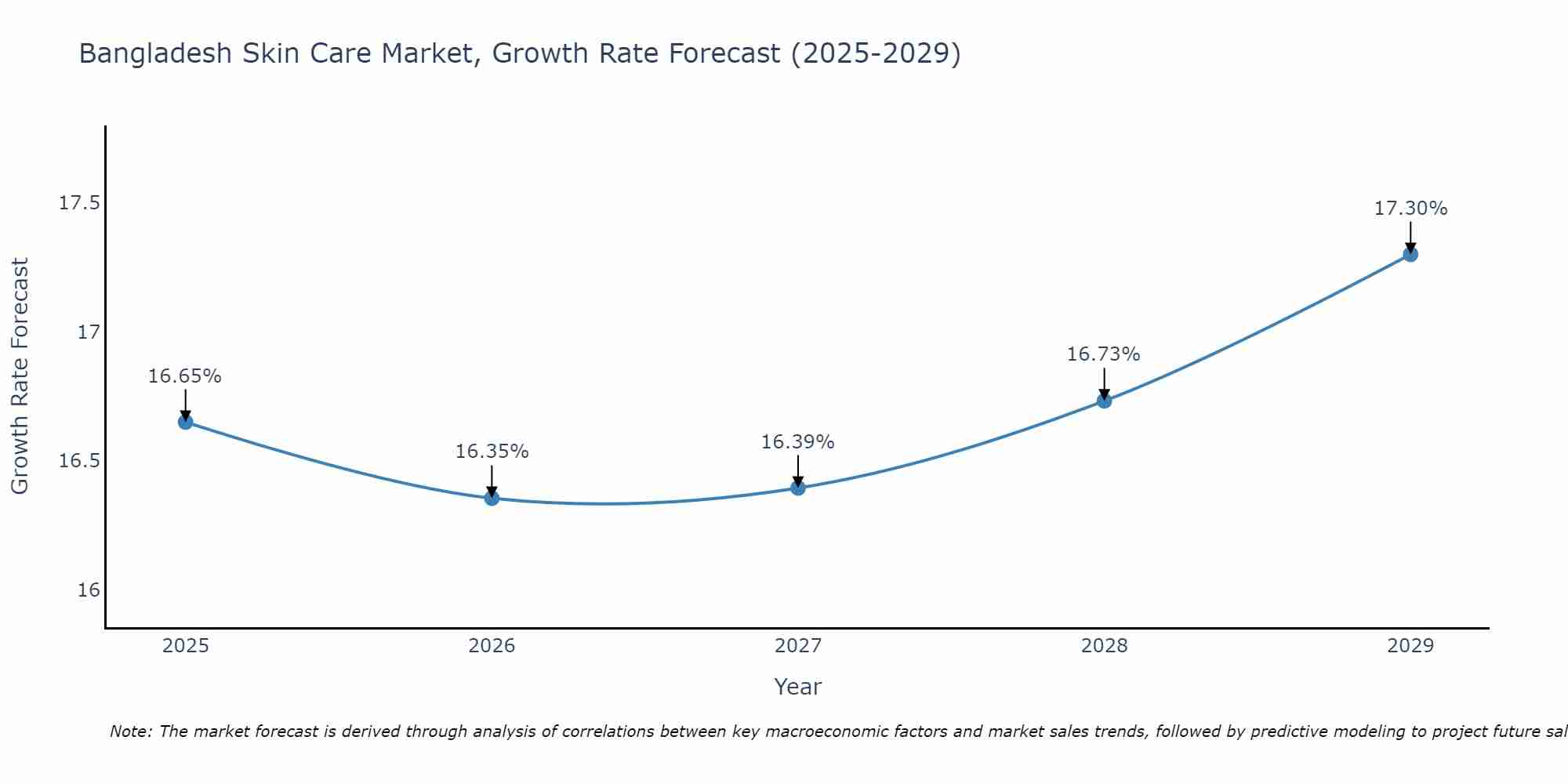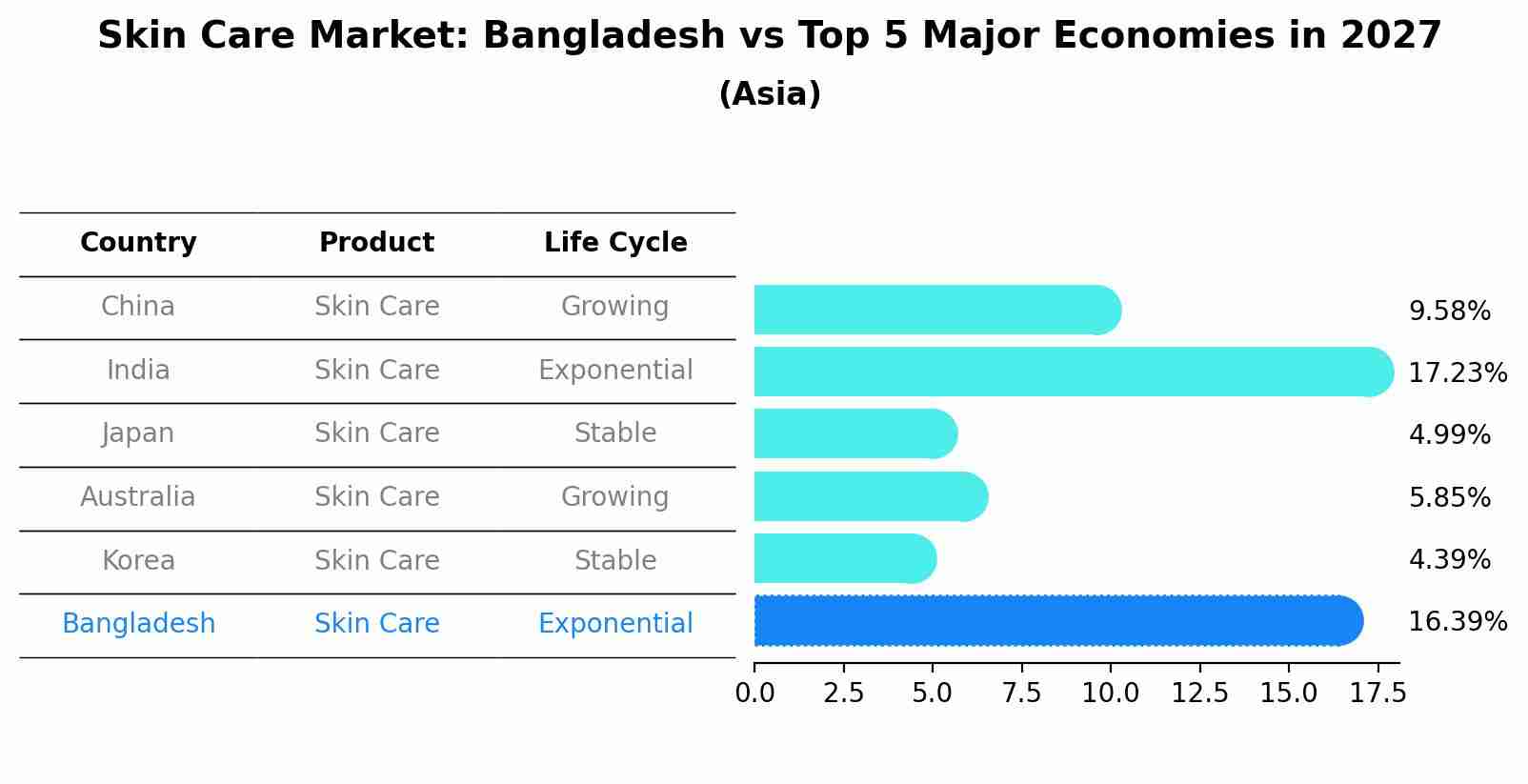Bangladesh Skin Care Market (2025-2031) | Industry, Trends, Size, Value, Companies, Analysis, Outlook, Growth, Forecast, Revenue & Share
| Product Code: ETC010432 | Publication Date: Oct 2020 | Updated Date: Jun 2025 | Product Type: Report | |
| Publisher: 6Wresearch | Author: Shubham Deep | No. of Pages: 70 | No. of Figures: 35 | No. of Tables: 5 |
Bangladesh Skin Care Market Size Growth Rate
The Bangladesh Skin Care Market is projected to witness mixed growth rate patterns during 2025 to 2029. From 16.65% in 2025, the growth rate steadily ascends to 17.30% in 2029.

Skin Care Market: Bangladesh vs Top 5 Major Economies in 2027 (Asia)
In the Asia region, the Skin Care market in Bangladesh is projected to expand at a exponential growth rate of 16.39% by 2027. The largest economy is China, followed by India, Japan, Australia and South Korea.

Bangladesh Skin Care Market Overview
The Bangladesh skin care market is experiencing significant growth driven by increasing consumer awareness of personal grooming and beauty products. The market is characterized by a wide range of products including lotions, creams, serums, masks, and sunscreens catering to various skin concerns such as hydration, anti-aging, and acne treatment. Local and international brands compete in the market, with consumers showing a preference for products that offer natural ingredients and effective results at affordable prices. Rising disposable incomes, urbanization, and the influence of social media are also key factors driving market growth. Moreover, the demand for skincare products among both men and women is on the rise, expanding the market further and presenting opportunities for new product innovations and marketing strategies.
Bangladesh Skin Care Market Trends
The Bangladesh Skin Care Market is experiencing a shift towards natural and organic products, driven by increasing consumer awareness of the benefits of using chemical-free skincare products. There is a growing demand for products that are ethically sourced, environmentally friendly, and free from harmful ingredients. In addition, there is a rising interest in skincare products that target specific skin concerns, such as hyperpigmentation, acne, and aging. Brands are focusing on innovative formulations and packaging to stand out in the competitive market. E-commerce platforms are playing a significant role in driving sales growth, offering consumers convenient access to a wide range of skincare products. Overall, the market is witnessing a trend towards conscious consumerism, with an emphasis on transparency, sustainability, and efficacy in skincare products.
Bangladesh Skin Care Market Challenges
In the Bangladesh skin care market, several challenges exist that impact the industry. One major challenge is the presence of counterfeit products, which not only affects the credibility of genuine brands but also poses health risks to consumers. Additionally, limited consumer awareness about the importance of skin care and the availability of quality products hinders market growth. The dominance of traditional home remedies and lack of access to dermatological advice also contribute to challenges in the market. Furthermore, price sensitivity among consumers and the presence of a large number of unorganized local brands make it difficult for international players to establish a strong foothold. Overall, addressing these challenges through education, regulatory measures, and innovative marketing strategies will be crucial for the growth of the skin care market in Bangladesh.
Bangladesh Skin Care Market Investment Opportunities
The Bangladesh skin care market presents promising investment opportunities due to the increasing consumer awareness and demand for skin care products. Rising disposable income levels, changing lifestyles, and a growing middle-class population are driving the market`s growth. Opportunities exist in segments such as anti-aging products, sun care products, organic and natural skincare products, and men`s grooming products. Investing in innovative product development, effective marketing strategies, and distribution channels can help companies capitalize on the evolving preferences of Bangladeshi consumers. Additionally, partnerships with local beauty influencers and celebrities can enhance brand visibility and credibility in the market. Overall, the Bangladesh skin care market offers a favorable environment for investors looking to tap into the country`s burgeoning beauty and personal care sector.
Bangladesh Skin Care Market Government Policy
The Bangladesh government has implemented regulations to ensure the safety and quality of skin care products in the market. The Directorate General of Drug Administration (DGDA) oversees the registration and licensing of cosmetics, including skin care products, to ensure they meet the required standards. Additionally, the government has set guidelines for labeling requirements, ingredient restrictions, and advertising practices to protect consumer interests and promote transparency in the industry. Importantly, the government also monitors and enforces regulations to prevent the sale of counterfeit or substandard products, safeguarding public health and promoting a competitive and trustworthy skin care market in Bangladesh.
Bangladesh Skin Care Market Future Outlook
The Bangladesh skin care market is poised for significant growth in the coming years, driven by factors such as increasing disposable income, changing lifestyles, and a growing awareness of skincare products among consumers. The market is expected to benefit from the rising demand for natural and organic products, as well as the influence of social media and beauty trends. Key players in the industry are likely to focus on innovation, product diversification, and marketing strategies to capitalize on the expanding consumer base. With a young population and a growing middle class, the Bangladesh skin care market presents opportunities for both domestic and international brands to establish a strong presence and cater to the evolving preferences of consumers. Overall, the market is projected to experience robust growth and remain a key sector within the beauty and personal care industry in Bangladesh.
Key Highlights of the Report:
- Bangladesh Skin Care Market Outlook
- Market Size of Bangladesh Skin Care Market, 2024
- Forecast of Bangladesh Skin Care Market, 2026
- Historical Data and Forecast of Bangladesh Skin Care Revenues & Volume for the Period 2021 - 2031
- Bangladesh Skin Care Market Trend Evolution
- Bangladesh Skin Care Market Drivers and Challenges
- Bangladesh Skin Care Price Trends
- Bangladesh Skin Care Porter's Five Forces
- Bangladesh Skin Care Industry Life Cycle
- Historical Data and Forecast of Bangladesh Skin Care Market Revenues & Volume By Product Types for the Period 2021 - 2031
- Historical Data and Forecast of Bangladesh Skin Care Market Revenues & Volume By Face Creams for the Period 2021 - 2031
- Historical Data and Forecast of Bangladesh Skin Care Market Revenues & Volume By Body Lotions for the Period 2021 - 2031
- Historical Data and Forecast of Bangladesh Skin Care Market Revenues & Volume By Distribution Channel for the Period 2021 - 2031
- Historical Data and Forecast of Bangladesh Skin Care Market Revenues & Volume By Online for the Period 2021 - 2031
- Historical Data and Forecast of Bangladesh Skin Care Market Revenues & Volume By Offline for the Period 2021 - 2031
- Bangladesh Skin Care Import Export Trade Statistics
- Market Opportunity Assessment By Product Types
- Market Opportunity Assessment By Distribution Channel
- Bangladesh Skin Care Top Companies Market Share
- Bangladesh Skin Care Competitive Benchmarking By Technical and Operational Parameters
- Bangladesh Skin Care Company Profiles
- Bangladesh Skin Care Key Strategic Recommendations
Frequently Asked Questions About the Market Study (FAQs):
1 Executive Summary |
2 Introduction |
2.1 Key Highlights of the Report |
2.2 Report Description |
2.3 Market Scope & Segmentation |
2.4 Research Methodology |
2.5 Assumptions |
3 Bangladesh Skin Care Market Overview |
3.1 Bangladesh Country Macro Economic Indicators |
3.2 Bangladesh Skin Care Market Revenues & Volume, 2019 & 2026F |
3.3 Bangladesh Skin Care Market - Industry Life Cycle |
3.4 Bangladesh Skin Care Market - Porter's Five Forces |
3.5 Bangladesh Skin Care Market Revenues & Volume Share, By Product Types, 2019 & 2026F |
3.6 Bangladesh Skin Care Market Revenues & Volume Share, By Distribution Channel, 2019 & 2026F |
4 Bangladesh Skin Care Market Dynamics |
4.1 Impact Analysis |
4.2 Market Drivers |
4.3 Market Restraints |
5 Bangladesh Skin Care Market Trends |
6 Bangladesh Skin Care Market, By Types |
6.1 Bangladesh Skin Care Market, By Product Types |
6.1.1 Overview and Analysis |
6.1.2 Bangladesh Skin Care Market Revenues & Volume, By Product Types, 2016 - 2026F |
6.1.3 Bangladesh Skin Care Market Revenues & Volume, By Face Creams, 2016 - 2026F |
6.1.4 Bangladesh Skin Care Market Revenues & Volume, By Body Lotions, 2016 - 2026F |
6.2 Bangladesh Skin Care Market, By Distribution Channel |
6.2.1 Overview and Analysis |
6.2.2 Bangladesh Skin Care Market Revenues & Volume, By Online, 2016 - 2026F |
6.2.3 Bangladesh Skin Care Market Revenues & Volume, By Offline, 2016 - 2026F |
7 Bangladesh Skin Care Market Import-Export Trade Statistics |
7.1 Bangladesh Skin Care Market Export to Major Countries |
7.2 Bangladesh Skin Care Market Imports from Major Countries |
8 Bangladesh Skin Care Market Key Performance Indicators |
9 Bangladesh Skin Care Market - Opportunity Assessment |
9.1 Bangladesh Skin Care Market Opportunity Assessment, By Product Types, 2019 & 2026F |
9.2 Bangladesh Skin Care Market Opportunity Assessment, By Distribution Channel, 2019 & 2026F |
10 Bangladesh Skin Care Market - Competitive Landscape |
10.1 Bangladesh Skin Care Market Revenue Share, By Companies, 2024 |
10.2 Bangladesh Skin Care Market Competitive Benchmarking, By Operating and Technical Parameters |
11 Company Profiles |
12 Recommendations |
13 Disclaimer |
- Single User License$ 1,995
- Department License$ 2,400
- Site License$ 3,120
- Global License$ 3,795
Search
Thought Leadership and Analyst Meet
Our Clients
Related Reports
- Germany Breakfast Food Market (2026-2032) | Industry, Share, Growth, Size, Companies, Value, Analysis, Revenue, Trends, Forecast & Outlook
- Australia Briquette Market (2025-2031) | Growth, Size, Revenue, Forecast, Analysis, Trends, Value, Share, Industry & Companies
- Vietnam System Integrator Market (2025-2031) | Size, Companies, Analysis, Industry, Value, Forecast, Growth, Trends, Revenue & Share
- ASEAN and Thailand Brain Health Supplements Market (2025-2031) | Strategy, Consumer Insights, Analysis, Investment Trends, Opportunities, Growth, Size, Share, Industry, Revenue, Segments, Value, Segmentation, Supply, Forecast, Restraints, Outlook, Competition, Drivers, Trends, Demand, Pricing Analysis, Competitive, Strategic Insights, Companies, Challenges
- ASEAN Bearings Market (2025-2031) | Strategy, Consumer Insights, Analysis, Investment Trends, Opportunities, Growth, Size, Share, Industry, Revenue, Segments, Value, Segmentation, Supply, Forecast, Restraints, Outlook, Competition, Drivers, Trends, Demand, Pricing Analysis, Competitive, Strategic Insights, Companies, Challenges
- Europe Flooring Market (2025-2031) | Outlook, Share, Industry, Trends, Forecast, Companies, Revenue, Size, Analysis, Growth & Value
- Saudi Arabia Manlift Market (2025-2031) | Outlook, Size, Growth, Trends, Companies, Industry, Revenue, Value, Share, Forecast & Analysis
- Uganda Excavator, Crane, and Wheel Loaders Market (2025-2031) | Strategy, Consumer Insights, Analysis, Investment Trends, Opportunities, Growth, Size, Share, Industry, Revenue, Segments, Value, Segmentation, Supply, Forecast, Restraints, Outlook, Competition, Drivers, Trends, Demand, Pricing Analysis, Competitive, Strategic Insights, Companies, Challenges
- Rwanda Excavator, Crane, and Wheel Loaders Market (2025-2031) | Strategy, Consumer Insights, Analysis, Investment Trends, Opportunities, Growth, Size, Share, Industry, Revenue, Segments, Value, Segmentation, Supply, Forecast, Restraints, Outlook, Competition, Drivers, Trends, Demand, Pricing Analysis, Competitive, Strategic Insights, Companies, Challenges
- Kenya Excavator, Crane, and Wheel Loaders Market (2025-2031) | Strategy, Consumer Insights, Analysis, Investment Trends, Opportunities, Growth, Size, Share, Industry, Revenue, Segments, Value, Segmentation, Supply, Forecast, Restraints, Outlook, Competition, Drivers, Trends, Demand, Pricing Analysis, Competitive, Strategic Insights, Companies, Challenges
Industry Events and Analyst Meet
Whitepaper
- Middle East & Africa Commercial Security Market Click here to view more.
- Middle East & Africa Fire Safety Systems & Equipment Market Click here to view more.
- GCC Drone Market Click here to view more.
- Middle East Lighting Fixture Market Click here to view more.
- GCC Physical & Perimeter Security Market Click here to view more.
6WResearch In News
- Doha a strategic location for EV manufacturing hub: IPA Qatar
- Demand for luxury TVs surging in the GCC, says Samsung
- Empowering Growth: The Thriving Journey of Bangladesh’s Cable Industry
- Demand for luxury TVs surging in the GCC, says Samsung
- Video call with a traditional healer? Once unthinkable, it’s now common in South Africa
- Intelligent Buildings To Smooth GCC’s Path To Net Zero


















